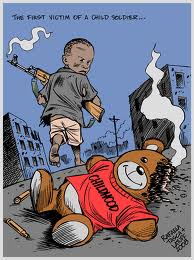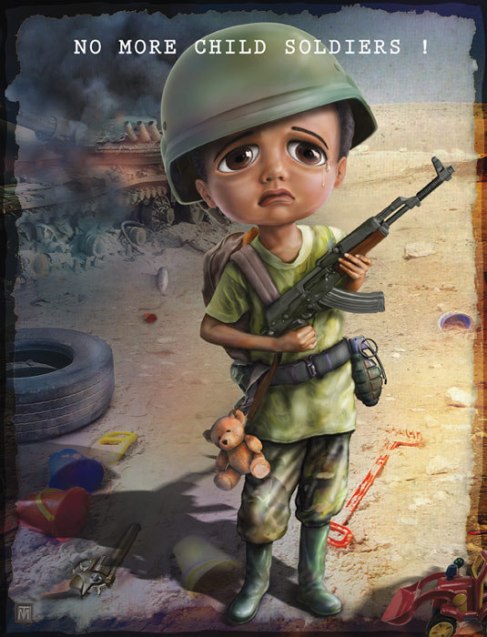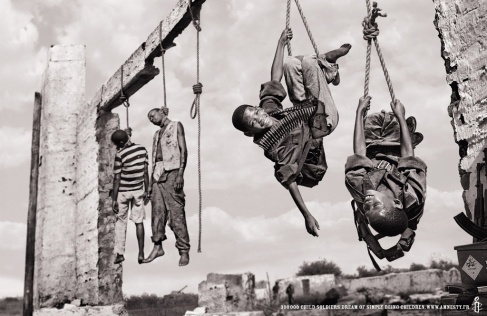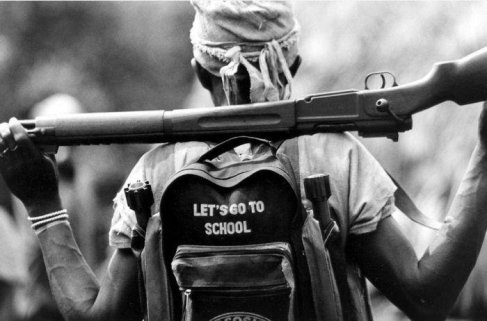“Childhood should be carefree, playing in the sun; not living a nightmare in the darkness of the soul” – Dave Pelzer
A child soldier may be defined as ‘any person less than 18 years of age who is a member of or attached to the armed forces or an armed group, whether or not there is an armed conflict.’
The age limitation of this definition is based upon the 1989 Convention on the Rights of the Child which is the most widely ratified convention in existence, which defines a child as any person under the age of 18.
In a recent incident in January 2013 the police in the southwestern Baluchistan province have arrested children from the age group of 8 to 17 years, during a raid near the provincial capital, Quetta. The United Baloch Army (UBA) a separatist group fighting the Pakistani government for years, has deployed a new weapon in its arsenal; child bombers to carry out attacks.
UBA had lured the children, who came from poor families, to leave packages containing homemade bombs in markets, dustbins and on routes used by police and security forces. The militants choose the youngsters knowing that police would not suspect small children.
Some of the children did not know what the packets contained and what they were doing. While some of the boys aged between 10 and 17 years have confessed to being involved in a dozen blasts in the city. The militant group paid them 25 to 50 dollars to drop of packages carrying bombs with timers.
For years, militants in Baluchistan a province rich in natural gas have been fighting for self rule. They complain that the government has paid little attention to them and their economic needs. While it’s the largest province in Pakistan it’s the poorest in per capita income. The terrorists exploit the innocence of the children to commit the crime.
Estimates suggest that as many as 300,000 or more child soldiers are active in conflicts around the world. 40% of armed forces (including national armies, militias, gangs, terrorist organizations and resistance forces) in the world use children. Child soldiers have been used by armed groups in recent and ongoing conflicts in Africa, South Asia, Southeast Asia, the Middle East and South America.
With the spread of communication, technology and increasing interdependence among countries we assume that every child has equal rights to education, employment, safety and security but this is not true. Till today many children suffer terrible hardships and are used to fight in conflicts they know little about. Research has shown that children need not necessarily be combatants. They may perform a variety of other tasks both military and non military including; scouting, spying, sabotage, training, acting as decoys, couriers, guards, porters, sexual slaves and forced labour.
Child soldiering is often portrayed as something new, a product of the post Cold War flow of cheap guns and money to the world’s most failed states. This is not true. The fact is that child soldiers have been around for a very long time. The Spartans of ancient Greece, for example relied heavily on boys as young as seven. Later the British Navy recruited young lads to serve as cabin boys and cannon prepping powder monkeys throughout the 18th and 19th centuries. Large numbers of children fought on both sides in the U.S. Civil War.
According to an Amnesty International report in 2000, “Both governments and armed groups use children because they are easier to condition into fearless killing and unthinking obedience. Children are a cheap and plentiful resource for military commanders in need of a steady troop supply to war zones. Their underdeveloped ability to assess danger means they are often willing to take risks and difficult assignments that adults or older teenagers will refuse.”
Numerous factors influence the recruitment of young children into conflicts they include; poverty, starvation, separation from their families, physical or sexual abuse, lack of livelihood and education. Children are most vulnerable in areas where conflicts have raged over a long period of time. If children are born into and raised in a conflict zone, they are more likely to be de-sensitized to violence. Many children volunteer to fight as they have few other options for a livelihood outside of an armed organization. The military or militia is seen as a meal ticket and a place for safety and security.
While some children volunteer for recruitment many others are conscripted or forcibly recruited and may be serving against their will. The most distressing method of recruitment is without a doubt kidnapping. The Lord’s Resistance Army (LRA) in Uganda has the worst record of abduction, stealing tens of thousands of children over the past decade alone. UNICEF reports that the LRA has abducted children as young as 5 but mostly between the ages of 8 and 16 years, often after killing their parents in front of them. Ugandans may be at highest risk of abduction, but children in other nations have plenty to fear as well. The Revolutionary United Front (RUF), a rebel group operating in Sierra Leone from 1991 to 2002, was notorious for raping and mutilating the civilian population. It was often coerced children who perpetrated the acts. The Liberation Tigers of Tamil Eelam, fighting for independence from Sri Lanka, relied on children for their suicide bombing missions during their decade long campaign.
In countries like Bhutan, Burundi, Myanmar, El Salvador, Ethiopia and Mozambique children have even been kidnapped while at school. The “Child Soldiers Report 2008” notes that the same is true in Bangladesh and Pakistan.
Warlords in Afghanistan and Angola’s National Union for the Total Independence of Angola (UNITA) have employed a quota system in which they demand that villages each hand over a certain number of youths. Those villages that don’t oblige are attacked.
In fact, both Britain and the United States also recruit 17 year olds, technically still children, on the grounds that they are not allowed into combat (though both have admitted to putting under 18 year old soldiers on the front lines in Afghanistan and Iraq in the recent war against terror ). Australia, Austria, Canada, Luxembourg, the Netherlands, and New Zealand all have similar policies.
Additionally the lines between compulsory, voluntary and forced recruitment are often blurred. Children may be subjected to various political and economic pressures that provide them with little alternative than to voluntarily join armed forces or armed groups.
Military commanders use proven tactics to produce unquestioning obedience in these homesick children while transforming them into killers. New recruits are often forced to kill or perpetrate various acts of violence against others, including strangers, escapees or even members of their own village or family. Coercing the children to harm or kill people they know has the added benefit of discouraging them from attempting escape, as they know they will no longer be welcome back home.
Some groups also practice cannibalism, making young recruits drink the blood or eat the flesh of their victims. While recruits are often told “It will make you stronger.” The real motivation is to force children to quiet their emotional reactions to seeing people killed and demolish their sense of the sanctity of life and their tendency to show respect for the dead.
In addition, drugs are administered to deaden the effects of conscience: amphetamines, crack cocaine, marijuana and tranquilizers help disengage the child’s actions from any sense of reality. Children who refuse to take the drugs are beaten or killed.Revenge is also used as a motivator. The children are told to visualize the enemy, the rebels who killed their parents and their families. While these tactics are very successful, the violence deeply affects the young consciences.
The international community primarily deals with child soldiers through deterrence (prosecuting the adult recruiters) and demobilization (taking away the children’s guns and sending them home). Neither approach goes far enough. In the first case, prosecutors hope to set an example for future would be offenders. But most recruiters think they will not get caught. Others knowing that only those who lose the fight get hauled before international courts desperately employ child soldiers to avoid defeat.
 Sending children home via disarmament, demobilization and reintegration (DDR) program is another favorite method of post conflict planners. These programs are meant to get children and adolescents out of armies and back where they belong in schools or in jobs. But here again, results are mixed. They often fail to understand the local economy and therefore train children for the wrong professions.
Sending children home via disarmament, demobilization and reintegration (DDR) program is another favorite method of post conflict planners. These programs are meant to get children and adolescents out of armies and back where they belong in schools or in jobs. But here again, results are mixed. They often fail to understand the local economy and therefore train children for the wrong professions.
The biggest challenge of all in ending child soldiering lies in the types of conflicts that employ the young. Children tend to be recruited in brutal, long running civil wars, the kind that simmers for years or even decades. Unfortunately, these wars constitute the main form of armed conflict today. Until they stop, the recruitment of children will never stop.
We must act ahead of the problem through regulation, fighting organized crime and trafficking, nation building assistance and development. Thus making the world safer and a more responsible place for children to live in.
by Steffi Ebnett
References
Child Soldiers Global Report: “Coalition to Stop the Use of Child Soldiers” 2008 http://www.childsoldiersglobalreport.org/
Global March Against Child Labour Report on the Worst Forms of Child Labour, 2005 http://www.globalmarch.org/resourcecentre/world/bolivia
Jo Becker: “Child soldiers: A worldwide scourge” March 22nd 2012 http://articles.latimes.com/2012/mar/22/opinion/la-oe-becker-icc-child-soldiers-20120322
Lewis D. Eigen: “child soldiers are unfortunately nothing new” November 2nd 2009, http://scriptamus.wordpress.com/2009/11/02/child-soldiers-are unfortunately-nothing-new/
http://www.amnesty.org/en/children
Mark Drumbl: “Review – Reimagining Child Soldiers in International Law” http://thinkafricapress.com/legal/reimagining-child-soldiers-international-law-mark-drumbl
Paris Principles and Guidelines on children associated with armed forces or armed groups, http://www.unhcr.org/refworld/pdfid/465198442







